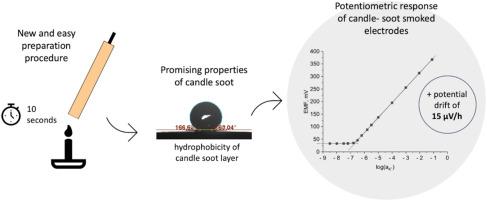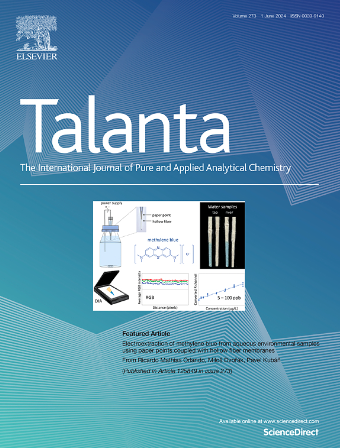蜡烛烟熏电极作为一种天然的超疏水材料用于电位传感器。
IF 6.1
1区 化学
Q1 CHEMISTRY, ANALYTICAL
引用次数: 0
摘要
介绍了碳烟作为固体接触层在电位传感器中的应用。从蜡烛制备碳层的方法成本低廉,只需10 s,并在本文范围内进行了优化和描述。通过使用所提出的程序,不仅可以覆盖玻碳圆盘电极,还可以覆盖各种形状和类型的所有表面,如铝箔或纸张。得到的烟尘层用钾选择膜浇铸,与文献中其他溶液的结果进行比较,但通过改变离子选择膜的组成可以实现对各种阳离子和阴离子的电极敏感。通过将蜡烛烟灰引入传感器,电极的电学和分析性能得到了显著改善。所设计的基于蜡烛烟灰的传感器对钾离子具有可重复和可逆的Nernstian响应,低检测限(10-6.7 M K+离子),显著的电位稳定性(漂移等于15 μV/h),选择性增强(与涂覆圆盘电极相比),响应时间短。所设计的传感器具有高电容量(C = 343 μF)和超疏水特性(高接触角- 165°),具有良好的分析性能。获得的传感器对氧化还原条件不敏感,使用寿命长。实验证明,直接从蜡烛中获得的碳层是电位计传感器固体接触层的合适材料,可以用简单快速的方法获得具有竞争参数的坚固的电位计传感器。本文章由计算机程序翻译,如有差异,请以英文原文为准。

Candle soot-smoked electrodes as a natural superhydrophobic material for potentiometric sensors
The application of carbon soot as a solid-contact layer in potentiometric sensor is presented. The preparation method of carbon layer from the candle is inexpensive and as short as 10 s and was optimized and described in the scope of this paper. With the use of the proposed procedure, it is possible to cover not only the glassy carbon disc electrodes, but all surfaces of various shapes and types, like foil or paper. Obtained soot layer was casted with potassium-selective membrane, for the comparison of results with other solutions presented in literature, however by changing the composition of ion-selective membrane it is possible to achieve electrodes sensitive to various cations and anions. By introducing the candle soot into the sensor, the electrical and analytical properties of electrode were significantly improved. Designed candle soot-based sensor exhibit repeatable and reversible Nernstian response towards potassium ions, low detection limit (10−6.7 M K+ ions), remarkable potential stability (drift equals to 15 μV/h) enhanced selectivity (in comparison with coated-disc electrode) and short response time. Designed sensors owe its great analytical properties to high electrical capacity (C = 343 μF) and superhydrophobic properties (proven by the high value of contact angle - 165°). Obtained sensors are insensitive to redox conditions and exhibit long lifetime. Performed tests proved that carbon layer obtained directly from the candle is appropriate material for solid-contact layer in potentiometric sensor and allows to obtain robust potentiometric sensor of competitive parameters using simple and fast procedure.
求助全文
通过发布文献求助,成功后即可免费获取论文全文。
去求助
来源期刊

Talanta
化学-分析化学
CiteScore
12.30
自引率
4.90%
发文量
861
审稿时长
29 days
期刊介绍:
Talanta provides a forum for the publication of original research papers, short communications, and critical reviews in all branches of pure and applied analytical chemistry. Papers are evaluated based on established guidelines, including the fundamental nature of the study, scientific novelty, substantial improvement or advantage over existing technology or methods, and demonstrated analytical applicability. Original research papers on fundamental studies, and on novel sensor and instrumentation developments, are encouraged. Novel or improved applications in areas such as clinical and biological chemistry, environmental analysis, geochemistry, materials science and engineering, and analytical platforms for omics development are welcome.
Analytical performance of methods should be determined, including interference and matrix effects, and methods should be validated by comparison with a standard method, or analysis of a certified reference material. Simple spiking recoveries may not be sufficient. The developed method should especially comprise information on selectivity, sensitivity, detection limits, accuracy, and reliability. However, applying official validation or robustness studies to a routine method or technique does not necessarily constitute novelty. Proper statistical treatment of the data should be provided. Relevant literature should be cited, including related publications by the authors, and authors should discuss how their proposed methodology compares with previously reported methods.
 求助内容:
求助内容: 应助结果提醒方式:
应助结果提醒方式:


